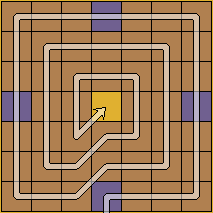
Chinese checkers or Chinese chequers is a strategy board game of German origin which can be played by two, three, four, or six people, playing individually or with partners. The game is a modern and simplified variation of the game Halma.

Ludo is a strategy board game for two to four players, in which the players race their four tokens from start to finish according to the rolls of a single die. Like other cross and circle games, Ludo is derived from the Indian game Pachisi, but simpler. The game and its variations are popular in many countries and under various names.
Parqués is the Colombian version of a board game in the cross and circle family. The game is described as a "random thinking" game: the moves depend on the roll of the dice but players must consider possible strategies before executing their move. The objective of the game is to advance all the pieces to the end.

Parcheesi is a brand-name American adaptation of the Indian cross and circle board game Pachisi, published by Parker Brothers and Winning Moves.

Tori shōgi is a variant of shogi, which was invented by Toyota Genryu in 1799 despite being traditionally attributed to his master Ōhashi Sōei. It was first published in 1828 and again in 1833. The game is played on a 7×7 board and uses the drop rule; it is the only traditional shogi variant, possibly besides wa shogi, to do so. This is one of the more popular shogi variants. There were tournaments in London and Royston in the 1990s and early 2000s.
Yari shogi is a modern variant of shogi ; however, it is not Japanese. It was invented in 1981 by Christian Freeling of the Netherlands. This game accentuates shogi’s intrinsically forward range of direction by giving most of the pieces the ability to move any number of free squares orthogonally forward like a shogi lance. The opposite is true of promoted pieces which can move backward with the same power.
Hand shogi is a variant of shogi, however it is not Japanese. It was invented in early 1997 by John William Brown of Lewisville, AR, USA. The name “hand” comes from the fact that each player starts the game with most of their pieces in hand and that each round of a match plays like the hand of a card game.
Whale Shogi is a modern variant of shogi. It is not, however, Japanese: it was invented by R. Wayne Schmittberger of the United States in 1981. The game is similar to Judkins shogi, but with more pieces, and the pieces are named after types of whale.
Heian shōgi is a predecessor of modern shogi. Some form of chess almost certainly reached Japan by the 9th century, if not earlier, but the earliest surviving Japanese description of the rules dates from the early 12th century. Unfortunately, this description does not give enough information to actually play the game, but this has not stopped people from attempting to reconstruct this early form of shogi.
Heian dai shogi is an early large board variant of shogi as it was played in the Heian period. The same 12th century document which describes the Heian form of shogi also describes this variant. Unfortunately, this description does not give enough information to actually play the game, but this has not stopped people from attempting to reconstruct this early form of shogi. A fairly complete and playable reconstruction is outlined here.
Dai dai shōgi is a large board variant of shogi. The game dates back to the 15th century and is based on the earlier dai shogi. Apart from its size, the major difference is in the range of the pieces and the "promotion by capture" rule. It is the smallest board variant to use this rule.
Kō shōgi is a large-board variant of shogi, or Japanese chess. The game dates back to the turn of the 18th century and is based on xiangqi and go as well as shogi. Credit for its invention has been given to Confucian scholar Ogyū Sorai.

Gess is a strategy board game for two players, involving a grid board and mutating pieces. The name was chosen as a conflation of "chess" and "go". It is pronounced with a hard "g" as in "go", and is thus homophonous with "guess".

Chowka Bara or Ashta Chamma is a two- or four-player board game from India. This game is an example of a partially observable system that involves an element of chance introduced by the roll of special dice and an element of strategy. While traditionally played with 4 or 6 cowry shells, dice can also be used.
Chopad is a Cross and Circle game played in Saurashtra, part of Gujarat, India.
Ashtāpada or Ashtapadi is an Indian board game which predates chess and was mentioned on the list of games that Gautama Buddha would not play. Chaturanga, which could be played on the same board, appeared sometime around the 6th century in India. It could be played by two to four participants.

The following outline is provided as an overview of and topical guide to chess:
Nana shogi is a modern variant of shogi ; however, it is not Japanese. It was invented in 1998–2001 by Georg Dunkel of Finland—who calls it the "World's Smallest Shogi Variant"—and it incorporates elements of Unashogi by starting with an empty board. A smaller variant, Gufuu Shogi (2×3), is also introduced by Georg Dunkel, but it incorporates rules considerably different from traditional shogi variants, particularly the concept of shared pieces and unusual rules for giving check and checkmate.













